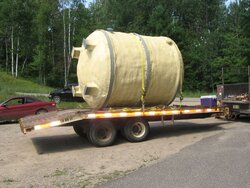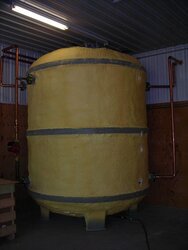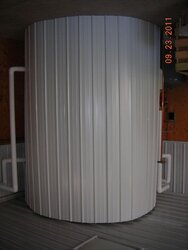Deep Portage, a 56,000 square feet educational institution located in north central MN, is in the midst of some big energy improvements, including this 4000 gallon storage tank to serve its Wood Gun E500 boiler. The tank will be plumbed to operate as a hydraulic separator and should be in operation by mid-September. Included will be digital panel meters and DS18b20 sensors for data logging at numerous locations. We also will be able to make an accurate determination of gpm flow using a differential pressure gauge, resulting in the opportunity to present even more accurate performance analysis this winter, along with improved performance analysis of the Garn WHS3200 fraternal twin also in operation.
Other energy improvements at Deep Portage include a Froling L50 with 1600 gallons storage to serve a separate structure, a solar voltaic array and solar hot air units (all to be on line in September); and an evacuated tube DHW solar heating array and wind turbine, both now in operation.
Other energy improvements at Deep Portage include a Froling L50 with 1600 gallons storage to serve a separate structure, a solar voltaic array and solar hot air units (all to be on line in September); and an evacuated tube DHW solar heating array and wind turbine, both now in operation.




